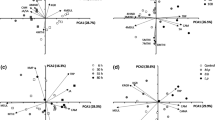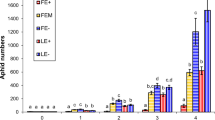Abstract
The occurrence of the alkaloidsN-formyl andN-acetyl loline, peramine, lolitrem B, and ergovaline and the response of aphids to plants containing these compounds were determined in species and cultivars ofFestuca,Lolium, and other grass genera infected with fungal endophytes (Acremonium spp., andEpichloe typhina). Twenty-nine of 34 host-fungus associations produced one or more of the alkaloids, most frequently peramine or ergovaline. Three alkaloids (lolines, peramine, and ergovaline) were found in tall fescue and in perennial ryegrass infected withA. coenophialum, while peramine, lolitrem B, and ergovaline were present in perennial ryegrass and in tall fescue infected withA. lolii and inF. longifolia infected withE. typhina. WhileA. coenophialum andA. lolii produced similar patterns of alkaloids regardless of the species or cultivar of grass they infected, isolates ofE. typhina produced either no alkaloids or only one or two different alkaloids in the grasses tested. Aphid bioassays indicated thatRhopalosiphum padi andSchizaphis graminum did not survive on grasses containing loline alkaloids and thatS. graminum did not survive on peramine-containing grasses. Ergovaline-containing grasses did not affect either aphid.
Similar content being viewed by others
References
Arachevaleta, M., Bacon, C.W., Hoveland, C.S., andRadcliffe, D.E. 1989. Effect of the tall fescue endophyte on plant response to environmental stress.Agron. J. 81:83–90.
Bacon, C.W. 1988. Procedure for isolating the endophyte from tall fescue and screening isolates for ergot alkaloids.Appl. Environ. Microbiol. 54:2615–2618.
Bacon, C.W., Lyons, P.C., Porter, J.K., andRobbins, J.D. 1986. Ergot toxicity from endophyte-infected grasses: A review.Agron. J. 78:106–116.
Barker, G.M., Prestidge, R.A., andPottinger, R.P. 1985. Strategies for Argentine stem weevil control: Effects of drought and endophyte.Proc. N.Z. Grass. Assoc. 47:107–114.
Belesky, D.P., Robbins, J.D., Stuedemann, J.A., Wilkinson, S.R., andDevine, O.J. 1987. Fungal endophyte infection-loline derivative alkaloid concentration of grazed tall fescue.Agron. J. 79:217–220.
Belesky, D.P., Stuedemann, J.A., Plattner, R.D., andWilkinson, S.R. 1988. Ergopeptine alkaloids in grazed tall fescue.Agron. J. 80:209–212.
Bush, L.P., Cornelius, P.L., Buckner, R.C., Varney, D.R., Chapman, R.A., Burriss, P.B., II, Kennedy, C.W., Jones, T.A., andSaunders, M.J. 1982. Association of N-acetyl loline and N-formyl loline withEpichloe typhina in tall fescue.Crop Sci. 22:941–943.
Clay, K. 1988. Clavicipitaceous fungal endophytes of grasses: coevolution and the change from parasitism to mutualism, pp. 79–105,in K. Pirozynski and D. Harkworth (eds.). Coevolution of Fungi with Plants and Animals. Academic Press, New York.
Clay, K. 1989. Clavicipitaceous endophytes of grasses: Their potential as biocontrol agents.Mycol. Res. 92:1–12.
Dahlman, D.L., Eichenseer, H., andSiegel, M.R. 1990. Chemical perspectives on endophytegrass interaction and their implications to insect herbivory,in P. Barbosa, L. Kirschik, and E. Jones (eds.). Multi-trophic Level Interactions among Microorganisms, Plants and Insects. John Wiley & Sons, New York. In press.
Diehl, W.W. 1950.Balansia and theBalansiae in America. Agriculture Monograph 4, U.S. Department of Agriculture, Washington, D.C.
Dymock, J.J., Rowan, D.D., andMcGee, I.R. 1989. Effects of endophyte-produced mycotoxins on Argentine stem weevil and the cutwormGraphonia mutans.Proc. Australas. Conf. Grassl. Invert. Ecol. 5:35–43.
Fannin, F.F., Bush, L.P., andSiegel, M.R. 1990. Analysis of peramine in fungal endophyteincfected grasses by reversed-phase thin-layer chromatography.J. Chromatogr. 503:288–292.
Funk, C.R.,Halisky, P.M.,Ahmad, S., andHurley, R.H. 1985. How endophytes modify turfgrass performance and response to insect pests in turfgrass breeding and evaluation trials, pp. 137–145,in F. Lemaire (ed.). Proceedings, Fifth International Turf Research Conference, Avignon, France.
Gallagher, R.T., Hawkes, A.D., andStewart, J.M. 1985. Rapid determination of the neurotoxin lolitrem B in perennial ryegrass by high-performance liquid chromatography with fluorescence detection.J. Chromatogr. 321:217–226.
Hill, N.S., Stringer, W.C., Rottenhaus, O.E., Belesky, O.P., Parrott, W.A., andPope, D.D. 1990. Growth, morphological and chemical component responses of tall fescue toAcremonium coenophialum.Crop. Sci. 30:156–161.
Johnson, M.C., Dahlman, D.L., Siegel, M.R., Bush, L.P., Latch, G.C.M., Potter, D.A., andVarney, D.R. 1985a. Insect feeding deterrents in endophyte-infected tall fescue.Appl. Environ. Microbiol. 49:568–571.
Johnson, M.C., Siegel, M.R., andSchmidt, B.A. 1985b. Serological reactivities of endophytic fungi from tall fescue and perennial ryegrass and ofEpichloe typhina.Plant Dis. 69:200–202.
Kennedy, C.W., andBush, L.P. 1983. Effect of environmental and management factors on the accumulation ofN-acetyl andN-formyl loline alkaloids in tall fescue.Crop Sci. 23:547–522.
Latch, G.C.M., andChristensen, M.J. 1985. Artificial infection of grasses with endophytes.Ann. Appl. Biol. 107:17–24.
Latch, G.C.M., Christensen, M.J., andSamuels, G.J. 1984. Five endophytes ofLolium andFestuca in New Zealand.Mycotaxon 20:535–550.
Latch, G.C.M., Hunt, W.F., andMusgrave, D.R. 1985. Endophytic fungi affect growth of perennial ryegrass.N.Z. J. Agric. Res. 28:165–168.
Latch, G.C.M., Potter, L.R., andTyler, B.F. 1987. Incidence of endophytes in seeds from collections ofLolium andFestuca species.Ann. Appl. Biol. 111:59–64.
Morgan-Jones, G., andGams, W. 1982. Notes on Hyphomycetes, XLI. An endophyte ofFestuca arundinacea and the anamorph ofEpichloe typhina, new taxa in one of two new sections ofAcremonium.Mycotaxon 15:311–318.
Mortimer, P.H., andDi Menna, M.E. 1985. Interactions ofLolium endophyte on pasture production and perennial ryegrass staggers disease, pp. 149–158,in J. Lacey (ed.). Trichothecenes and Other Mycotoxins. John Wiley & Sons, New York.
Prestidge, R.A., andGallagher, R.T. 1985. Lolitrem B-a stem weevil toxin isolated from Acremonium-infected ryegrass.Proc. N.Z. Weed Pest Control Conf. 38:38–40.
Read, J.C., andCamp, B.J. 1986. The effect of the fungal endophyteAcremonium coenophialum in tall fescue on animal performance, toxicity, and stand maintenance.Agron. J. 78:848–850.
Rowan, D.D., andGaynor, D.L. 1986. Isolation of feeding deterrents against Argentine stem weevil from ryegrass infected with the endophyteAcremonium loliae.J. Chem. Ecol. 12:647–658.
Rowan, D.D., andShaw, J.G. 1987. Detection of ergopeptine alkaloids in endophyte-infected perennial ryegrass by tandem mass spectrometry.N.Z. Vet. J. 35:197–198.
Shelby, R.A., andDalrymple, L.W. 1987. Incidence and distribution of the tall fescue endophyte in the United States.Plant Dis. 71:783–786.
Siegel, M.R., Latch, G.C.M., andJohnson, M.C. 1987. Fungal endophytes of grasses.Annu. Rev. Phytopathol. 25:293–315.
Stuedemann, J.A., andHoveland, C.S. 1988. Fescue endophyte: History and impact on animal agriculture.J. Prod. Agric. 1:39–44.
Tapper, B.A., Rowan, D.D., andLatch, G.C.M. 1989. Detection and measurement of the alkaloid peramine in endophyte-infected grasses.J. Chromatogr. 463:133–138.
Weedon, C.M., andMantle, P.G. 1987. Paxilline biosynthesis byAcremonium loliae; A step towards defining the origin of lolitrem neurotoxins.Phytochemistry 26:969–971.
White, J.F., Jr. 1987. Widespread distribution of endophytes in the Poaceae.Plant Dis. 71:340–342.
White, J.F., Jr. 1988. Endophyte-host associations in forage grasses. XI. A proposal concerning origin and evolution.Mycologia 80:442–446.
Yates, S.G., andPowell, R.G. 1988. Analysis of ergopeptine alkaloids in endophyte-infected tall fescue.J. Agric. Food Chem. 36:337–340.
Yates, S.G., Plattner, R.D., andGarner, G.B. 1985. Detection of ergopeptine alkaloids in endophyte infected, toxic Ky-31 tall fescue by mass spectrometry/mass spectrometry.J. Agric. Food Chem. 33:719–722.
Yates, S.G., Fenster, J.C., andBartelt, R.J. 1989. Assay of tall fescue seed extracts, fractions, and alkaloids using the large milkweed bug.J. Agric. Food Chem. 37:354–357.
Author information
Authors and Affiliations
Rights and permissions
About this article
Cite this article
Siegel, M.R., Latch, G.C.M., Bush, L.P. et al. Fungal endophyte-infected grasses: Alkaloid accumulation and aphid response. J Chem Ecol 16, 3301–3315 (1990). https://doi.org/10.1007/BF00982100
Received:
Accepted:
Issue Date:
DOI: https://doi.org/10.1007/BF00982100




